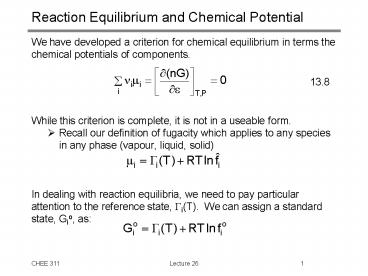Reaction Equilibrium and Chemical Potential - PowerPoint PPT Presentation
1 / 9
Title:
Reaction Equilibrium and Chemical Potential
Description:
... the Gibbs energy at standard conditions is of greatest interest. ... This is based on. the assumption that DHo is a weak. function of temperature over the ... – PowerPoint PPT presentation
Number of Views:55
Avg rating:3.0/5.0
Title: Reaction Equilibrium and Chemical Potential
1
Reaction Equilibrium and Chemical Potential
- We have developed a criterion for chemical
equilibrium in terms the chemical potentials of
components. - 13.8
- While this criterion is complete, it is not in a
useable form. - Recall our definition of fugacity which applies
to any species in any phase (vapour, liquid,
solid) - In dealing with reaction equilibria, we need to
pay particular attention to the reference state,
Gi(T). We can assign a standard state, Gio, as
2
Standard States
- For our purposes, the Gibbs energy at standard
conditions is of greatest interest. - This is the molar Gibbs energy of
- pure component i
- at the reaction temperature
- in a user-defined phase
- at a user-defined pressure (often 1 bar)
- A great deal of thermodynamic data are published
as the standard properties of formation at STP
(Table C.4 of the text) - DGfo is standard Gibbs energy of formation per
mole of the compound when formed from its
elements in its standard state at 25oC. - Gases pure, ideal gas at 1 bar
- Liquids pure substance at 1 bar
3
Chemical Potential and Activity
- Substituting our standard Gibbs energy (Gio) in
the place of Gi(T), the chemical potential of
component i in our system becomes - 13.9
- We define a new parameter, activity, to simplify
this expression - where,
- The activity of a component is the ratio of its
mixture fugacity to its pure component fugacity
at the standard state.
4
Reaction Equilibrium and Activity
- When a reactive system reaches an equilibrium
state, we know that the equilibrium criterion is
satisfied. Recall that chemical reaction
equilibrium requires - where ni is the stoichiometric coefficient of
component i and mi is the chemical potential of
component i at the given P,T, and composition. - Substituting our expression for chemical
equilibrium into the above equation gives us - Or,
5
The Equilibrium Constant
- Our equilibrium expression for reactive systems
can be expressed concisely in the form - 13.10
- where P signifies the product over all species.
- The right hand side of equation 15.12 is a
function of pure component properties alone, and
is therefore constant at a given temperature. - The equilibrium constant, K, for the reaction is
defined as - 13.11
- K is calculated from the standard Gibbs energies
of the pure components and the stoichiometric
coefficients of the reaction.
6
Standard Gibbs Energy Change of Reaction
- The conventional means of representing the
equilibrium constant uses DGo, the standard Gibbs
energy change the reaction. - Using this notation, our equilibrium constant
assumes the familiar form - 13.11
- When calculating an equilibrium constant (or
interpreting a literature value), pay attention
to standard state conditions. - Each Gio must represent the pure component at the
temperature of interest - The state of the component and the pressure are
arbitrary, but they must correspond with fio used
to calculate the activity of the component in the
mixture.
7
Temp. Dependence of Reaction Equilibrium
- Defined by the following relationship,
- the equilibrium constant is a function of
temperature. - Recall that DGo represents the standard Gibbs
energy of reaction at the specified temperature. - We know that
- From which we can derive the temperature
dependence of K - 13.14
- If we assume that DHo is independent of
temperature, we can integrate 15.16 directly to
yield - 13.15
8
K vs Temperature
- Equation 12.15 predicts that ln K
- versus 1/T is linear. This is based on
- the assumption that DHo is a weak
- function of temperature over the
- range of interest.
- This is true for a number of
- reactions, including those
- depicted by Figure13.2.
- A rigorous development of
- temperature dependence
- of K may be found in the text
9
Equilibrium State of a Reactive System
- Given that an equilibrium constant for a reaction
can be derived from the standard state Gibbs
energies of the pure components, we can define
the composition of the system at equilibrium. - Consider the gas phase reaction
- The equilibrium constant gives us
- Or

